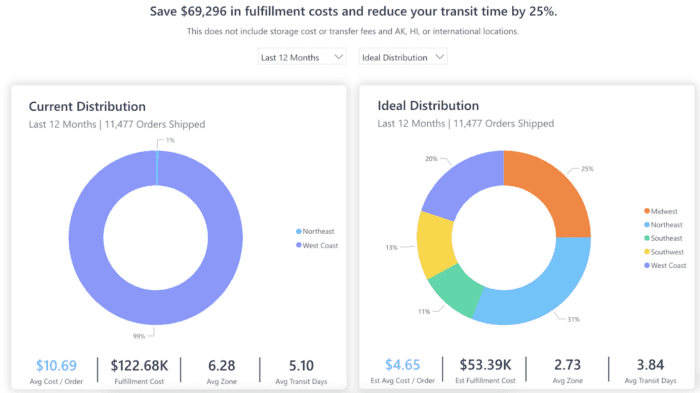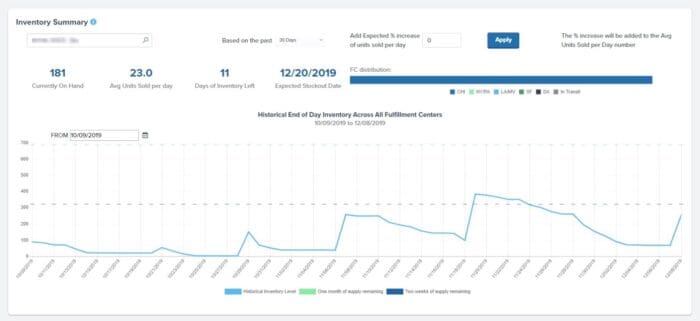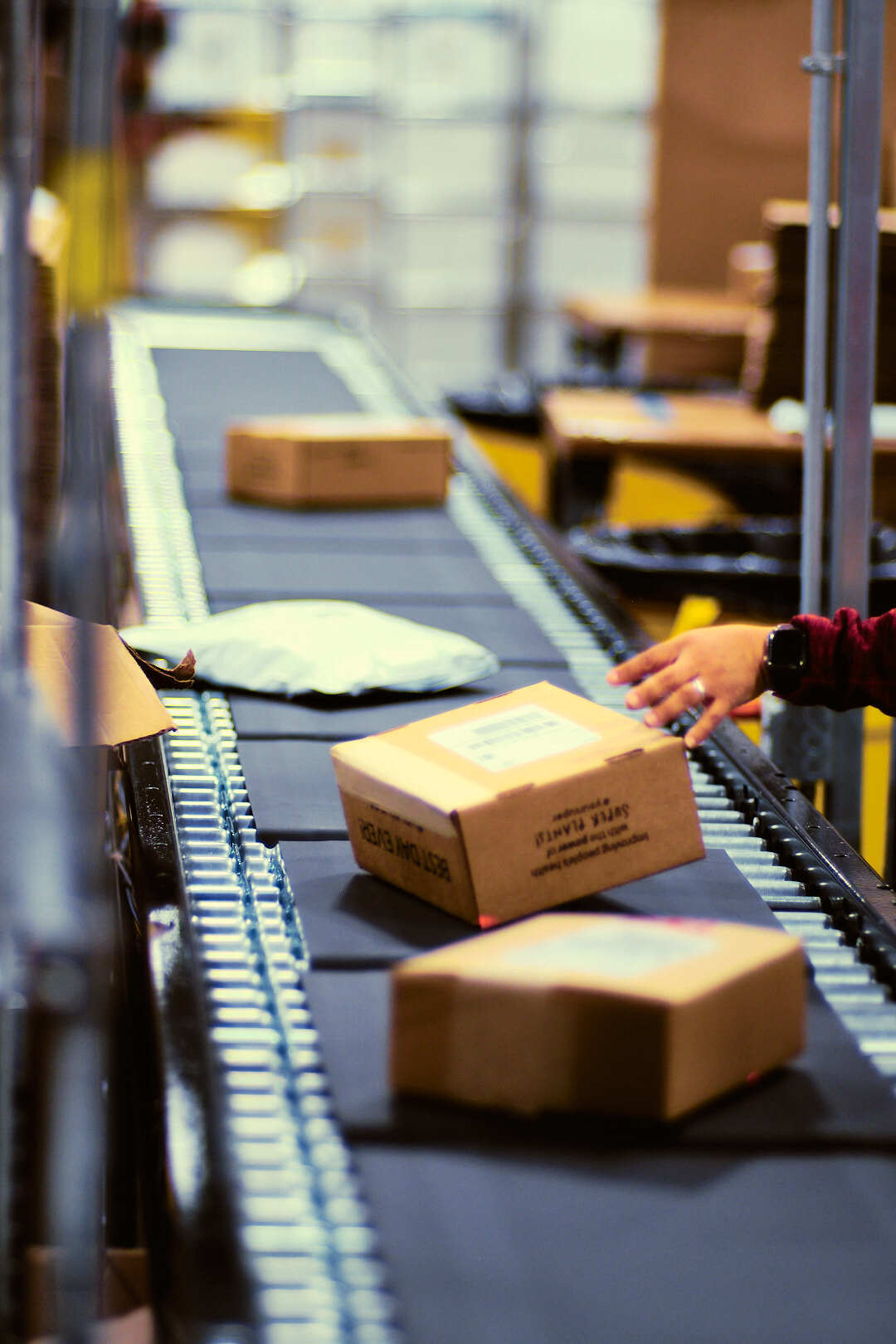Inefficiencies, bottlenecks, and unnecessary waste are detrimental to ecommerce warehouses. As a result, it’s important to implement lean warehousing practices to address these issues. Otherwise, your business may end up with high overhead costs that chip away at your bottom line. In other words, having a lean warehouse isn’t just optional – it’s an essential lever for maximising profits and boosting efficiency.
In this article, we’ll dive deep into what lean warehousing involves, some lean warehousing strategies, and how partners like ShipBob can help you add value to your brand while optimising your operations.
What is lean warehousing?
Lean warehousing is an approach to warehouse management where a business optimises its warehouse to eliminate unnecessary or inefficient processes, costs, or time consumption. The overall goal is to do more with less, and maximise productivity and profitability while minimising waste.
Lean warehousing doesn’t just happen on its own; rather, it requires implementing a set of intentional practices that streamline your warehousing operations. This may include the use of technology, such as warehouse management systems (WMS), warehouse control systems (WCS), and automated storage and retrieval systems (AS/RS).
Lean warehousing in action
It can be hard to understand what lean warehousing looks like until you see it.
Toyota’s production control system is a great example of lean warehousing in action. The system incorporates two concepts: jidoka (loosely translated as “automation with a human touch”) to prevent the product defects, and a “Just-in-Time” philosophy to ensure that every process produces only what’s necessary for the very next task.
Jidoka ensures that a piece of machinery automatically stops whenever a problem occurs, which keeps the company from manufacturing defective products and creating waste.
The “Just-in-Time” principle is best represented on the assembly lines at Toyota production centres. Each station on the line is stocked with the required number of parts, allowing workers to assemble any kind of ordered vehicle as soon as production instructions come in. These assembly lines are then restocked with the same number of parts used, so the process can continue as soon as the next order comes in.
But lean warehousing isn’t only for giant corporations. Smaller ecommerce businesses like Spikeball have successfully implemented lean warehousing practices, and achieved massive cost-savings as a result.
Previously, Spikeball relied heavily on manual processes and implicit knowledge in their fulfilment process. Their manager had to use guesswork when it came to what type of box an order would need and how much it would weigh. Shipping couriers were also selected based on what was assumed to be the cheapest option. Any inaccuracies in these calculations resulted in a bill from the courier.
But then, Spikeball partnered with ShipBob, and implemented ShipBob’s proprietary warehouse management system. This system automated these calculations, which significantly improved warehouse efficiency while saving time and labour costs for their team.
“We went from 3-4 people spending all day packing orders, and now we have our manager doing everything herself. She picks and packs orders from 7:00 am to noon, and then she’s done with DTC orders for the day. And now our team doesn’t have to rely on tribal knowledge for anything!”
Adam LaGesse, Global Warehousing Director at Spikeball
ShipBob’s team was also able to optimise inventory storage and picking paths within Spikeball’s warehouse, making picking quicker, easier, and even more accurate.
“Through the implementation process we learned that if you’re commonly picking certain items, they should be stored in the back so you aren’t carrying them around while you’re picking other items. Our best sellers are at the end of the pick path now, so once we’ve picked those, we’re already back at the pack stations.
We even changed the way we stowed products. For example, we would have similar items in the same area — take shirts, for instance. Because they were so close together, there was a high likelihood that we picked the wrong size or the wrong colour because all of our shirts looked similar and were physically right beside each other.
Once we set up ShipBob’s system, we were putting those similar items (that weren’t ordered together) in all different places in the warehouse. After that, our pick accuracy went way up. Getting out of our own way of thinking was eye-opening.”
Adam LaGesse, Global Warehousing Director at Spikeball
The five pillars of lean warehousing
A lot goes into lean management for warehouses. That said, successful lean methodology is usually built on the same five pillars:
1. Sort
To eliminate waste, you first need to know what’s waste and what’s not. Sorting warehousing tasks, operations, equipment, and more into one of two categories – “necessary” and “unnecessary” – can help you identify what assets your warehouse can’t function without, and which you can afford to automate or remove altogether.
At ShipBob, for example, we leverage proprietary technology to automate certain tasks, so our fulfilment team only takes on the most essential steps of receiving, putaway, picking, and packing. Cross-docking is also implemented on request at select distribution centres to eliminate the putaway and storage processes.
2. Set in order
An organised warehouse is an efficient warehouse. It’s important to physically arrange your warehouse layout to optimise inventory flow and increase efficiency.
For example, you should adjust your warehouse setup so that inventory and equipment are easily accessible. That way, everything can be accessed in the shortest amount of time possible and with the least amount of movement. Store popular items on lower shelves to make picking easier, and keep aisles wide enough to easily maneuver.
In ShipBob fulfilment centres, each SKU receives its own dedicated storage bin, shelf, or pallet, and pickers can easily navigate the warehouse space and aisles to ensure that the fulfilment process flows seamlessly.
3. Shine
A clean and clutter-free warehouse enables workers to do their jobs with minimal distractions or obstructions. It’s therefore essential to keep workspaces, tables, and floor spaces free of dust, spills, and clutter.
You should also schedule regular maintenance and repair of tools and equipment. This helps prevent malfunctions and accidents, which keeps your staff safe and your productivity timetable on track.
4. Standardize
Developing uniform systems, labelling conventions, and processes across your warehouse drives efficiency. This requires regular and comprehensive training so that every member of your staff has up-to-date knowledge and skills on what needs to be done.
ShipBob, for example, maintains standard work processes to ensure consistency and reliability while also providing ongoing training to every staff member.
5. Sustain
As your business grows, you’ll have to proactively work to keep your warehousing operations lean. This requires continually assessing each of these pillars and making necessary improvements to your existing strategies. At ShipBob, we maintain a culture that reinforces these lean warehousing practices while making regular optimizations to sustain them.
How to measure efficiency in warehouse operations
While you might feel your efforts are working, you’ll need hard data to determine if your warehouse is actually becoming more efficient. Constantly monitoring performance metrics related to your warehouse productivity and efficiency will help you identify areas of improvement and make constant optimizations for a lean warehouse.
Some of the essential warehouse KPIs you should monitor are:
- Receiving efficiency
- Receiving cycle time
- Put-away cycle time
- Put-away accuracy
- Picking efficiency
- Picking accuracy
- Picking cycle time
- Order lead time
- Order cycle time
- On-time shipping rate
- Time lost due to injury
- Accidents per year
ShipBob’s analytics and reporting features keep track of these vital warehouse metrics in one place so that merchants can make more informed, data-led decisions. Our analytics dashboard provides data on the efficiency and accuracy of your fulfilment operations, along with real-time inventory metrics. For example, we can optimise inventory distribution based on recommendations from the Ideal Distribution Tool to reduce transit time and cut down on fulfilment costs.

The role of technology in lean warehousing
Technology plays an ever-increasingly prominent role in lean warehousing. By automating time-consuming activities and minimising manual warehouse processes, the right technology can go a long way towards improving your warehouse’s efficiency and bottom line.
Warehouse management systems (WMS)
Warehouse management systems give you better visibility into your warehouse operations and inventory, and let you control them from a single platform. A WMS like ShipBob’s allows you to virtually see your warehouse, so you can get both a bird’s eye view of productivity as well as a detailed breakdown of different performance metrics.
“ShipBob’s software allows for all of us to “virtually see” our warehouse without having to physically be there. Because of that, we’ve been able to reduce our product speed-to-market, catch and remediate quality control issues, and intercept orders (as our fulfilment associates are able to physically see, touch, count, and ship items). All of that is amazing.
The merchant dashboard is still really helpful for support inquiries (if an order needs to be canceled, if we need to adjust an address, add a product, etc.), as ShipBob is our source of truth for shipping data. I also love the analytics tools, and so do my accountants. I can also see how my team is doing, tracking their order metrics as they fulfil orders. While we now pay for our own rent and the salaries of our fulfilment centre team, we have been able to save 10% and reinvest that into other parts of the business. It’s been game-changing.”
Courtney Lee, Founder of Prymal
With a WMS, warehouse staff knows exactly where and how to store inventory, which speeds up the putaway process. This also allows picking staff to quickly retrieve the items from their picking lists. Moreover, a WMS can generate optimised picking lists to reduce travel time and ensure that pickers can complete their trips in the shortest amount of time possible.
A WMS also increases productivity by reducing the risk of human errors and inaccuracies. For instance, accurate inventory counts through barcode scanners mean that your employees aren’t wasting time recounting inventory. Similarly, automatic packaging recommendations mean that packers don’t have to waste time repackaging products.
Automation and robotics
The use of warehouse automation tools and robotics minimises the need for manual labour in several parts of the warehouse, allowing you to dedicate staff to more human-intensive activities. In some cases, automation assists human workers and allows them to do their jobs faster and with greater accuracy.
Sometimes, automated systems help warehouses optimise storage space and improve efficiency in various fulfilment activities. For example, an automated storage and retrieval system such as vertical lift modules optimises space utilisation while enabling warehouses to quickly retrieve items that need to be picked.
ShipBob leverages a number of automated solutions to maintain lean warehousing practices. Our automated taping machine, for example, significantly reduces the time it takes to pack orders and get them ready for shipping. Once packed, packages are transported using conveyor belts and sorted using a package sorter, which further speeds up the fulfilment process.
3 lean warehousing strategies
Once you’re ready to get started optimising your warehousing, try implementing these tips to make the process easier.
Adopt the “lean” mindset
The greatest challenge of lean warehousing implementation isn’t changing existing procedures; it’s changing your team’s existing culture and mindset.
Even if you manage to make all the initial improvements, you may have a hard time sustaining them if you don’t have support at all levels of the organisation. It can be hard to let go of “the old way of doing things”, but emphasize the value of lean warehouse management to your organisation, and how key it is to the business’s overall success. Getting everyone on board with the changes will help facilitate a smoother transition.
Continuously analyse, adapt, and improve
Lean warehousing isn’t a one-time exercise. Rather, it is a continuous improvement process that deserves consistent attention.
In that sense, it’s important to sustain the practices by conducting regular audits and making necessary improvements to get even better results. Similarly, you should provide ongoing support and training to your team so that everyone has the necessary skills and knowledge to maintain a lean warehouse.
Adopt a warehouse management system (WMS)
With the ability to give you better visibility and control over your warehouse operations, a warehouse management system plays a vital role in implementing lean warehousing. Make the most of a WMS to automate your processes and improve efficiency at various aspects of your warehouse workflow.
The future of lean warehousing
Modern warehouses are increasingly adopting automation and robotics to streamline material handling and follow lean warehousing principles. Lots of this automation focuses on inventory storage and retrieval, enabling businesses to speed up these aspects of the warehousing operation.
In the future, we can expect to see improved efficiency resulting from automated picking and packing technology that streamlines the process and reduces human error. ShipBob, for example, is already using box selection algorithms and machines to automatically determine the ideal box for each package based on dimensions and weight, helping us minimise packaging waste. ShipBob also incorporates automated taping machines that speed up the packing process and minimise the need for manual work.
Innovations on the horizon
Brands can also expect additional innovations with upcoming developments in the fields of augmented reality and IoT. For instance, AR glasses may help workers to access real-time information on item locations and ideal routes, which will significantly speed up travel time and minimise picking errors, for example.
IoT technology can help warehouses get actionable data to inform their inventory management. Deploying sensors and other connected devices will enable them to get real-time data on inventory levels, warehouse temperature, etc., so they can take necessary action. This allows them to follow just-in-time inventory management, preventing spoilage and unnecessary waste.
ShipBob’s plan for lean warehousing and agile fulfilment
ShipBob’s approach to fulfilment and warehousing aligns with lean principles to ensure that you can improve efficiency and reduce unnecessary costs. Our tech-enabled fulfilment centres are equipped to automate and streamline different aspects of storage and order fulfilment, which adds speed and accuracy to your operations. Real-time inventory tracking and comprehensive analytics enable brands to balance inventory levels (to avoid stockouts, overstocking, and overproduction) and allocate stock to better meet customer demand and reduce waste.
Outsource your lean warehousing worries to ShipBob
Although lean warehousing has a number of benefits, implementing it and sustaining it can be a challenge for ecommerce businesses of all sizes. With ShipBob, you can outsource fulfilment to the experts, so you don’t have to handle the complexities of implementing a lean warehouse yourself.
Our full-stack fulfilment services take care of supply chain operations for you, including:
- Receiving
- Putaway
- Picking
- Packing
- Shipping
In all of these functions, ShipBob’s experienced team implements best practices and lean warehousing strategies on your behalf, so your operations are optimised for time and cost.
You can also leverage our global network of fulfilment centres so you can strategically distribute your inventory. You even get optimal distribution recommendations to reduce transit time and shipping costs by storing inventory closer to your customers.
Keep things in-house, but better: Adopt ShipBob’s WMS
If you prefer to keep things in-house (or opt for hybrid fulfilment), ShipBob will let you use our proprietary WMS within your own four walls to help you achieve a leaner warehouse.
Our cloud-based WMS gives you full visibility into your warehousing operations, so you can manage your processes even without being physically present.You can use the system to get location-specific inventory visibility, so you know exactly where your inventory is at all times. This enables warehouse staff to easily identify where each product is stored, assisting them in the putaway and picking processes. You’ll also be able to get order counts at various stages of fulfilment and quickly identify orders that need to be prioritized.
Combined with intelligent cycle counts, this inventory tracking capability also helps you get an accurate idea of your inventory levels so you can plan your procurement strategically to avoid creating unnecessary waste. You can even set order points and get notified when stock quantity hits a certain level.

ShipBob’s WMS comes with features to help you maximise pick and pack efficiency, enabling you to implement lean warehousing principles. It analyses the optimal method specific to your warehouse – whether it’s batch, auto-cluster, custom cluster, or single-order picking. This helps you find the picking method that’s ideal for improving efficiency in your warehouse.
Moreover, our intuitive dashboard allows you to train and onboard new packers in a matter of minutes. Built-in visuals and prescriptive, visual step-by-step flows help to reduce packing errors that could cause disruptions and delays in your operations.
ShipBob even provides you with complimentary consultations with experts to guide you in warehouse efficiency and change management. This, along with ongoing support for operational optimisation and strategic planning, ensures that you can successfully implement and sustain lean warehousing for your ecommerce business.
To learn more about how ShipBob’s solutions can help your brand create a leaner warehouse, click the button below.
Lean warehousing FAQs
Below are answers to common questions about lean warehousing.
How does lean warehousing reduce costs?
Lean warehousing reduces operational costs by eliminating waste and unnecessary processes.
Can lean warehousing improve customer satisfaction?
Lean warehousing can improve customer satisfaction by improving fulfilment efficiency and accuracy, ensuring that customers can get exactly what they ordered at the right time.
What are the first steps to implementing lean warehousing?
The first steps to implementing lean warehousing are:
- Identifying and sorting which processes and tools are necessary versus unnecessary
- Organising your warehouse intuitively to promote efficiency
- Decluttering and cleaning your warehouse
- Creating standardized, easily-repeatable processes
- Continuously re-evaluating your warehousing operations to spot opportunities for improvement



